Everyday Use人物分析
- 格式:docx
- 大小:16.00 KB
- 文档页数:3
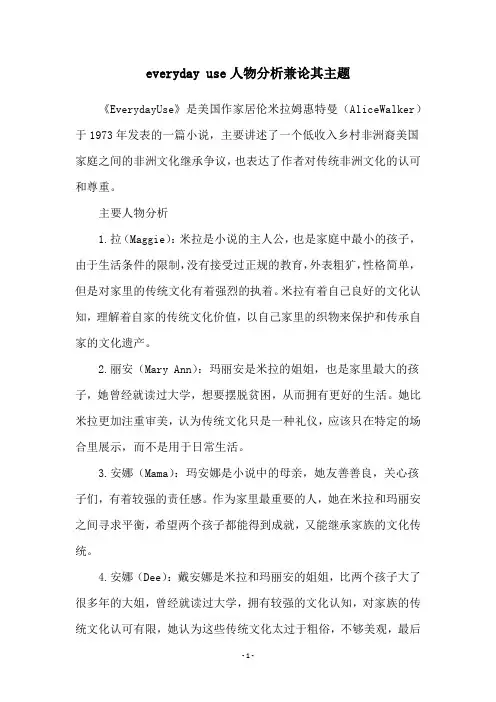
everyday use人物分析兼论其主题《EverydayUse》是美国作家居伦米拉姆惠特曼(AliceWalker)于1973年发表的一篇小说,主要讲述了一个低收入乡村非洲裔美国家庭之间的非洲文化继承争议,也表达了作者对传统非洲文化的认可和尊重。
主要人物分析1.拉(Maggie):米拉是小说的主人公,也是家庭中最小的孩子,由于生活条件的限制,没有接受过正规的教育,外表粗犷,性格简单,但是对家里的传统文化有着强烈的执着。
米拉有着自己良好的文化认知,理解着自家的传统文化价值,以自己家里的织物来保护和传承自家的文化遗产。
2.丽安(Mary Ann):玛丽安是米拉的姐姐,也是家里最大的孩子,她曾经就读过大学,想要摆脱贫困,从而拥有更好的生活。
她比米拉更加注重审美,认为传统文化只是一种礼仪,应该只在特定的场合里展示,而不是用于日常生活。
3.安娜(Mama):玛安娜是小说中的母亲,她友善善良,关心孩子们,有着较强的责任感。
作为家里最重要的人,她在米拉和玛丽安之间寻求平衡,希望两个孩子都能得到成就,又能继承家族的文化传统。
4.安娜(Dee):戴安娜是米拉和玛丽安的姐姐,比两个孩子大了很多年的大姐,曾经就读过大学,拥有较强的文化认知,对家族的传统文化认可有限,她认为这些传统文化太过于粗俗,不够美观,最后把它们拿来当做收藏品展示在家里。
人物特征看,米拉在家庭有著最深厚的文化认知,追求著文化的承和煌;而玛丽安家族文化有度反感,希望能摆脱贫困,过上更好的生活。
玛安娜在米拉和玛丽安之,她既知道家族文化的重要性,也理解玛丽安改善生活的追求,於双方的力求公平,人都能得到尊重。
戴安娜於家族的传统文化有限的认可,而她想要把它们拿当做收藏品展示在家里,展示自家文化的象征性,也是於家族文化的致敬。
最,《Everyday Use》的主题是“文化继承”。
作者用家族中三名不同文化认知水平的主要人物来表现这个主题,讲述了家庭中个孩子在文化继承上的分歧。
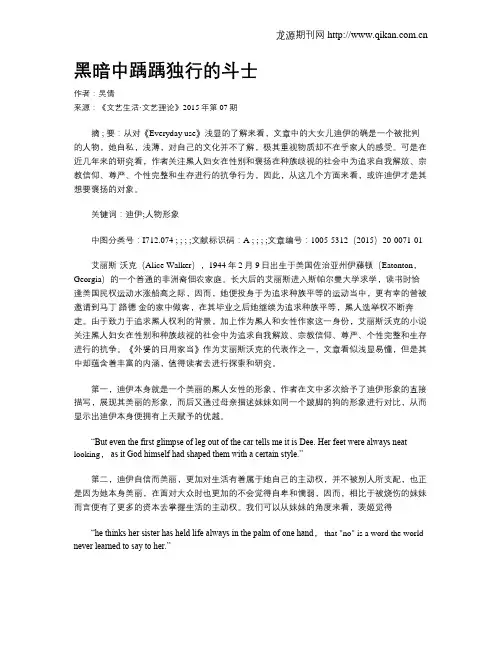
黑暗中踽踽独行的斗士作者:吴倩来源:《文艺生活·文艺理论》2015年第07期摘 ; 要:从对《Everyday use》浅显的了解来看,文章中的大女儿迪伊的确是一个被批判的人物,她自私,浅薄,对自己的文化并不了解,极其重视物质却不在乎家人的感受。
可是在近几年来的研究看,作者关注黑人妇女在性别和褒扬在种族歧视的社会中为追求自我解放、宗教信仰、尊严、个性完整和生存进行的抗争行为,因此,从这几个方面来看,或许迪伊才是其想要褒扬的对象。
关键词:迪伊;人物形象中图分类号:I712.074 ; ; ; ;文献标识码:A ; ; ; ;文章编号:1005-5312(2015)20-0071-01艾丽斯·沃克(Alice Walker),1944年2月9日出生于美国佐治亚州伊藤顿(Eatonton,Georgia)的一个普通的非洲裔佃农家庭。
长大后的艾丽斯进入斯帕尔曼大学求学,读书时恰逢美国民权运动水涨船高之际,因而,她便投身于为追求种族平等的运动当中,更有幸的曾被邀请到马丁路德金的家中做客,在其毕业之后她继续为追求种族平等,黑人选举权不断奔走。
由于致力于追求黑人权利的背景,加上作为黑人和女性作家这一身份,艾丽斯沃克的小说关注黑人妇女在性别和种族歧视的社会中为追求自我解放、宗教信仰、尊严、个性完整和生存进行的抗争。
《外婆的日用家当》作为艾丽斯沃克的代表作之一,文章看似浅显易懂,但是其中却蕴含着丰富的内涵,值得读者去进行探索和研究。
第一,迪伊本身就是一个美丽的黑人女性的形象,作者在文中多次给予了迪伊形象的直接描写,展现其美丽的形象,而后又通过母亲描述妹妹如同一个跛脚的狗的形象进行对比,从而显示出迪伊本身便拥有上天赋予的优越。
“But even the first glimpse of leg out of the car tells me it is Dee. Her feet were always neat-looking,as it God himself had shaped them with a certain style.”第二,迪伊自信而美丽,更加对生活有着属于她自己的主动权,并不被别人所支配,也正是因为她本身美丽,在面对大众时也更加的不会觉得自卑和懦弱,因而,相比于被烧伤的妹妹而言便有了更多的资本去掌握生活的主动权。
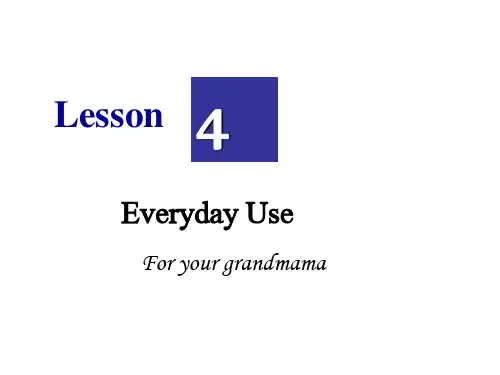
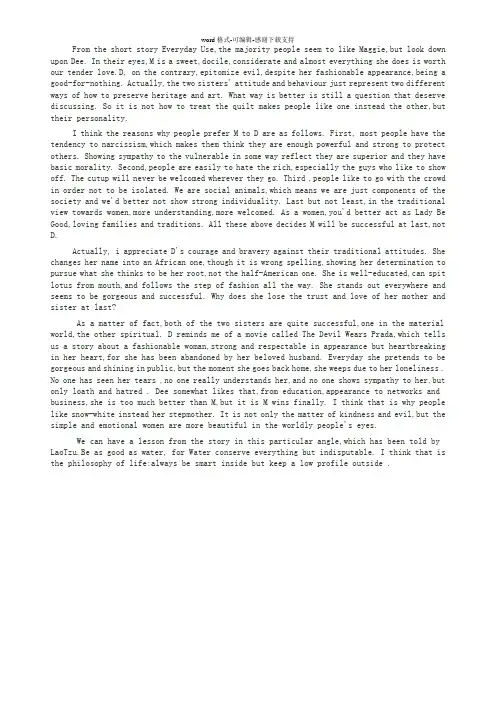
word格式-可编辑-感谢下载支持From the short story Everyday Use,the majority people seem to like Maggie,but look down upon Dee. In their eyes,M is a sweet,docile,considerate and almost everything she does is worth our tender love.D, on the contrary,epitomize evil,despite her fashionable appearance,being a good-for-nothing. Actually,the two sisters' attitude and behaviour just represent two different ways of how to preserve heritage and art. What way is better is still a question that deserve discussing. So it is not how to treat the quilt makes people like one instead the other,but their personality.I think the reasons why people prefer M to D are as follows. First, most people have the tendency to narcissism,which makes them think they are enough powerful and strong to protect others. Showing sympathy to the vulnerable in some way reflect they are superior and they have basic morality. Second,people are easily to hate the rich,especially the guys who like to show off. The cutup will never be welcomed wherever they go. Third ,people like to go with the crowd in order not to be isolated. We are social animals,which means we are just components of the society and we'd better not show strong individuality. Last but not least,in the traditional view towards women,more understanding,more welcomed. As a women,you'd better act as Lady Be Good,loving families and traditions. All these above decides M will be successful at last,not D.Actually, i appreciate D's courage and bravery against their traditional attitudes. She changes her name into an African one,though it is wrong spelling,showing her determination to pursue what she thinks to be her root,not the half-American one. She is well-educated,can spit lotus from mouth,and follows the step of fashion all the way. She stands out everywhere and seems to be gorgeous and successful. Why does she lose the trust and love of her mother and sister at last?As a matter of fact,both of the two sisters are quite successful,one in the material world,the other spiritual. D reminds me of a movie called The Devil Wears Prada,which tells us a story about a fashionable woman,strong and respectable in appearance but heartbreaking in her heart,for she has been abandoned by her beloved husband. Everyday she pretends to be gorgeous and shining in public,but the moment she goes back home,she weeps due to her loneliness . No one has seen her tears ,no one really understands her,and no one shows sympathy to her,but only loath and hatred . Dee somewhat likes that,from education,appearance to networks and business,she is too much better than M,but it is M wins finally. I think that is why people like snow-white instead her stepmother. It is not only the matter of kindness and evil,but the simple and emotional women are more beautiful in the worldly people's eyes.We can have a lesson from the story in this particular angle,which has been told by LaoTzu.Be as good as water, for Water conserve everything but indisputable. I think that is the philosophy of life:always be smart inside but keep a low profile outside .。
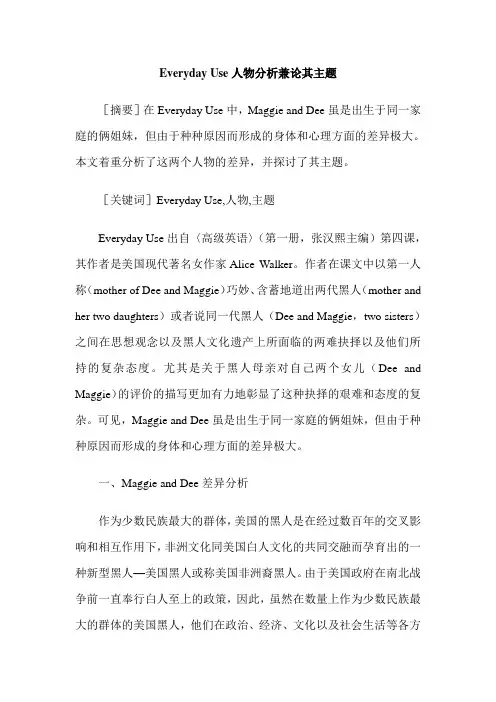
Everyday Use人物分析兼论其主题[摘要]在Everyday Use中,Maggie and Dee虽是出生于同一家庭的俩姐妹,但由于种种原因而形成的身体和心理方面的差异极大。
本文着重分析了这两个人物的差异,并探讨了其主题。
[关键词]Everyday Use,人物,主题Everyday Use出自〈高级英语〉(第一册,张汉熙主编)第四课,其作者是美国现代著名女作家Alice Walker。
作者在课文中以第一人称(mother of Dee and Maggie)巧妙、含蓄地道出两代黑人(mother and her two daughters)或者说同一代黑人(Dee and Maggie,two sisters)之间在思想观念以及黑人文化遗产上所面临的两难抉择以及他们所持的复杂态度。
尤其是关于黑人母亲对自己两个女儿(Dee and Maggie)的评价的描写更加有力地彰显了这种抉择的艰难和态度的复杂。
可见,Maggie and Dee虽是出生于同一家庭的俩姐妹,但由于种种原因而形成的身体和心理方面的差异极大。
一、Maggie and Dee差异分析作为少数民族最大的群体,美国的黑人是在经过数百年的交叉影响和相互作用下,非洲文化同美国白人文化的共同交融而孕育出的一种新型黑人—美国黑人或称美国非洲裔黑人。
由于美国政府在南北战争前一直奉行白人至上的政策,因此,虽然在数量上作为少数民族最大的群体的美国黑人,他们在政治、经济、文化以及社会生活等各方面却一直处于无权和被压迫的境地。
Alice Walke生于1944年,此时的美国在政治上较之从前已经发生了天翻地覆的变化。
比如说,轰轰烈烈的、席卷全国的废奴运动业已结束,发端于20 世纪20年代纽约市黑人聚居区—哈莱姆的“黑人文艺复兴”也方兴未艾。
因此,她所耳闻目睹的美国黑人无论在政治、经济还是文化等方面都有了明显的改观。
事实上,Alice Walke时代的美国黑人正面临着这样一种两难抉择:一方面,他们要不失时机地与白人交流和融合;另一方面,他们又必须想方设法地保全自己的传统和文化。
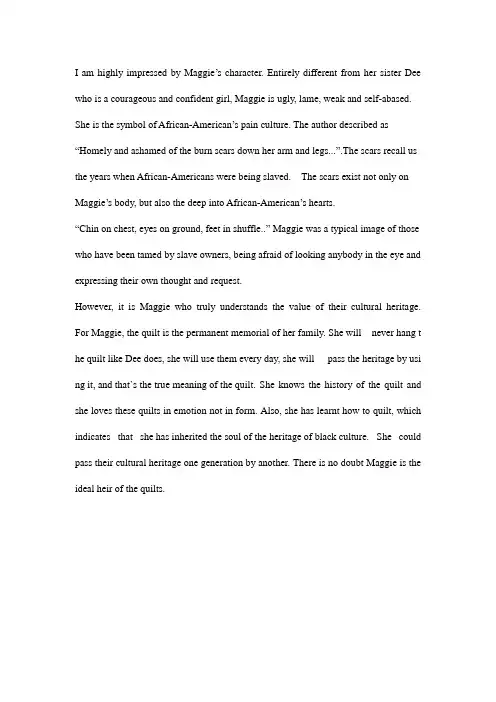
I am highly impressed by Maggie’s character. Entirely different from her sister Dee who is a courageous and confident girl, Maggie is ugly, lame, weak and self-abased. She is the symbol of African-American’s pain culture. The author described as “Homely and ashamed of the burn scars down her arm and legs...”.The scars recall us the years when African-Americans were being slaved. The scars exist not only on Maggie’s body, but also the deep into African-American’s hearts.“Chin on chest, eyes on ground, feet in shuffle..” Maggie was a typical image of those who have been tamed by slave owners, being afraid of looking anybody in the eye and expressing their own thought and request.However, it is Maggie who truly understands the value of their cultural heritage. For Maggie, the quilt is the permanent memorial of her family. She will never hang t he quilt like Dee does, she will use them every day, she will pass the heritage by usi ng it, and that`s the true meaning of the quilt. She knows the history of the quilt and she loves these quilts in emotion not in form. Also, she has learnt how to quilt, which indicates that she has inherited the soul of the heritage of black culture. She could pass their cultural heritage one generation by another. There is no doubt Maggie is the ideal heir of the quilts.。
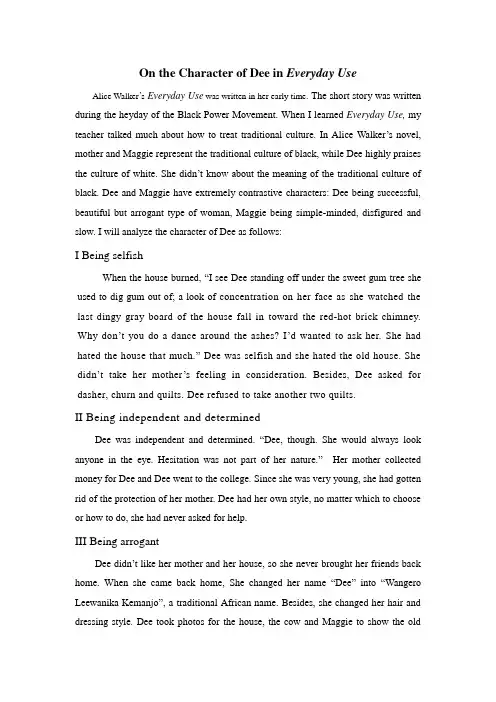
On the Character of Dee in Everyday Use Alice Walker’s Everyday Use was written in her early time. The short story was written during the heyday of the Black Power Movement. When I learned Everyday Use, my teacher talked much about how to treat traditional culture. In Alice Walker’s novel, mother and Maggie represent the traditional culture of black, while Dee highly praises the culture of white. She didn’t know about the meaning of the traditional culture of black. Dee and Maggie have extremely contrastive characters: Dee being successful, beautiful but arrogant type of woman, Maggie being simple-minded, disfigured and slow. I will analyze the character of Dee as follows:I Being selfishWhen the house burned, “I see Dee standing off under the sweet gum tree she used to dig gum out of; a look of concentration on her face as she watched the last dingy gray board of the house fall in toward the red-hot brick chimney. Why don’t you do a dance around the ashes? I’d wanted to ask her. She had hated the house that much.” Dee was selfish and she hated the old house. She didn’t take her mother’s feeling in consideration. Besides, Dee asked for dasher, churn and quilts. Dee refused to take another two quilts.II Being independent and determinedDee was independent and determined. “Dee, though. She would always look anyone in the eye. Hesitation was not part of her nature.”Her mother collected money for Dee and Dee went to the college. Since she was very young, she had gotten rid of the protection of her mother. Dee had her own style, no matter which to choose or how to do, she had never asked for help.III Being arrogantDee didn’t like her mother and her house, so she never brought her friends back home. When she came back home, She changed her name “Dee”into “Wangero Leewanika Kemanjo”, a traditional African name. Besides, she changed her hair and dressing style. Dee took photos for the house, the cow and Maggie to show the oldfashion off to her friends. But now it was different, Dee not only took photos, but also took her boyfriend back home. Compared with her former attitude towards everyday use, Dee showed tremendous cherish. She walked around the house to seek anything that had long history.In the past, the mother wanted to give the quilts to her elder daughter Dee. But Dee rejected them as too old-fashioned and out of style. Therefore the mother promised the quilts to her younger daughter Maggie. Now Dee asks her mother for the quilts and some more pieces of their family heritage because she now regards them as part of her cultural heritage, which she intends to hang on the wall. She wanted to show that she knew about African culture. So she was arrogant.In the end, against the expectation of Dee, the mother refused her wish and gave the quilts to Maggie, who would have agreed to give the quilts to her sister. Dee left without a piece of her family heritage, with her mother being satisfied with their simple southern life and with her sister Maggie, who would put the quilts to everyday use.From this novel, we should learn to have a right attitude to our culture and know the real meaning.。

word格式-可编辑-感谢下载支持From the short story Everyday Use,the majority people seem to like Maggie,but look down upon Dee. In their eyes,M is a sweet,docile,considerate and almost everything she does is worth our tender love.D, on the contrary,epitomize evil,despite her fashionable appearance,being a good-for-nothing. Actually,the two sisters' attitude and behaviour just represent two different ways of how to preserve heritage and art. What way is better is still a question that deserve discussing. So it is not how to treat the quilt makes people like one instead the other,but their personality.I think the reasons why people prefer M to D are as follows. First, most people have the tendency to narcissism,which makes them think they are enough powerful and strong to protect others. Showing sympathy to the vulnerable in some way reflect they are superior and they have basic morality. Second,people are easily to hate the rich,especially the guys who like to show off. The cutup will never be welcomed wherever they go. Third ,people like to go with the crowd in order not to be isolated. We are social animals,which means we are just components of the society and we'd better not show strong individuality. Last but not least,in the traditional view towards women,more understanding,more welcomed. As a women,you'd better act as Lady Be Good,loving families and traditions. All these above decides M will be successful at last,not D.Actually, i appreciate D's courage and bravery against their traditional attitudes. She changes her name into an African one,though it is wrong spelling,showing her determination to pursue what she thinks to be her root,not the half-American one. She is well-educated,can spit lotus from mouth,and follows the step of fashion all the way. She stands out everywhere and seems to be gorgeous and successful. Why does she lose the trust and love of her mother and sister at last?As a matter of fact,both of the two sisters are quite successful,one in the material world,the other spiritual. D reminds me of a movie called The Devil Wears Prada,which tells us a story about a fashionable woman,strong and respectable in appearance but heartbreaking in her heart,for she has been abandoned by her beloved husband. Everyday she pretends to be gorgeous and shining in public,but the moment she goes back home,she weeps due to her loneliness . No one has seen her tears ,no one really understands her,and no one shows sympathy to her,but only loath and hatred . Dee somewhat likes that,from education,appearance to networks and business,she is too much better than M,but it is M wins finally. I think that is why people like snow-white instead her stepmother. It is not only the matter of kindness and evil,but the simple and emotional women are more beautiful in the worldly people's eyes.We can have a lesson from the story in this particular angle,which has been told by LaoTzu.Be as good as water, for Water conserve everything but indisputable. I think that is the philosophy of life:always be smart inside but keep a low profile outside .。
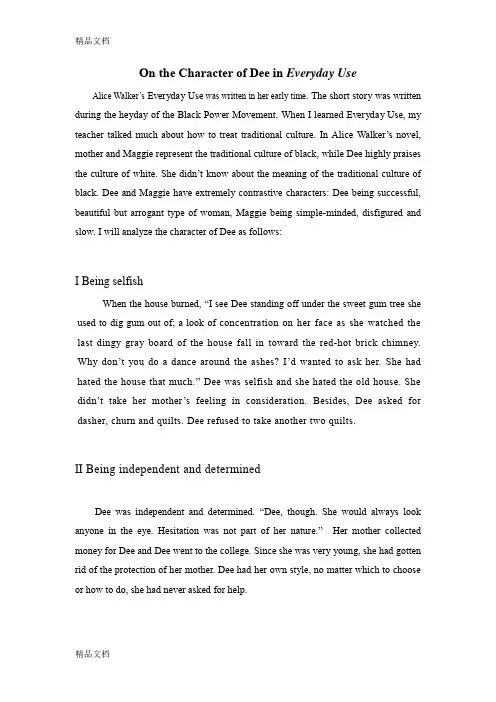
On the Character of Dee in Everyday Use Alice Walker’s Everyday Use was written in her early time. The short story was written during the heyday of the Black Power Movement. When I learned Everyday Use, my teacher talked much about how to treat traditional culture. In Alice Walker’s novel, mother and Maggie represent the traditional culture of black, while Dee highly praises the culture of white. She didn’t know about the meaning of the traditional culture of black. Dee and Maggie have extremely contrastive characters: Dee being successful, beautiful but arrogant type of woman, Maggie being simple-minded, disfigured and slow. I will analyze the character of Dee as follows:I Being selfishWhen the house burned, “I see Dee standing off under the sweet gum tree she used to dig gum out of; a look of concentration on her face as she watched the last dingy gray board of the house fall in toward the red-hot brick chimney. Why don’t you do a dance around the ashes? I’d wanted to ask her. She had hated the house that much.” Dee was selfish and she hated the old house. She didn’t take her mother’s feeling in consideration. Besides, Dee asked for dasher, churn and quilts. Dee refused to take another two quilts.II Being independent and determinedDee was independent and determined. “Dee, though. She would always look anyone in the eye. Hesitation was not part of her nature.”Her mother collected money for Dee and Dee went to the college. Since she was very young, she had gotten rid of the protection of her mother. Dee had her own style, no matter which to choose or how to do, she had never asked for help.III Being arrogantDee didn’t like her mother and her house, so she never brought her friends back home. When she came back home, She changed her name “Dee”into “Wangero Leewanika Kemanjo”, a traditional African name. Besides, she changed her hair and dressing style. Dee took photos for the house, the cow and Maggie to show the old fashion off to her friends. But now it was different, Dee not only took photos, but also took her boyfriend back home. Compared with her former attitude towards everyday use, Dee showed tremendous cherish. She walked around the house to seek anything that had long history.In the past, the mother wanted to give the quilts to her elder daughter Dee. But Dee rejected them as too old-fashioned and out of style. Therefore the mother promised the quilts to her younger daughter Maggie. Now Dee asks her mother for the quilts and some more pieces of their family heritage because she now regards them as part of her cultural heritage, which she intends to hang on the wall. She wanted to show that she knew about African culture. So she was arrogant.In the end, against the expectation of Dee, the mother refused her wish and gave the quilts to Maggie, who would have agreed to give the quilts to her sister. Dee left without a piece of her family heritage, with her mother being satisfied with their simple southern life and with her sister Maggie, who would put the quilts to everyday use.From this novel, we should learn to have a right attitude to our culture and know the real meaning.。
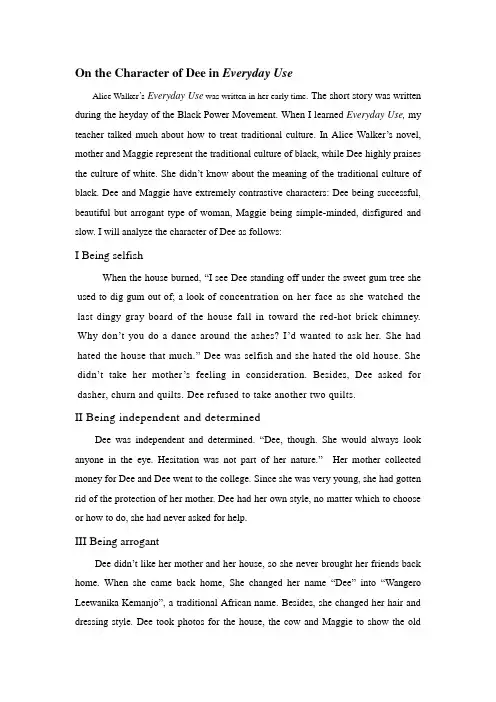
On the Character of Dee in Everyday UseAlice Walker’s Everyday Use was written in her early time. The short story was written during the heyday of the Black Power Movement. When I learned Everyday Use, my teacher talked much about how to treat traditional culture. In Alice Walker’s novel, mother and Maggie represent the traditional culture of black, while Dee highly praises the culture of white. She didn’t know about the meaning of the traditional culture of black. Dee and Maggie have extremely contrastive characters: Dee being successful, beautiful but arrogant type of woman, Maggie being simple-minded, disfigured and slow. I will analyze the character of Dee as follows:I Being selfishWhen the house burned, “I see Dee standing off under the sweet gum tree she used to dig gum out of; a look of concentration on her face as she watched the last dingy gray board of the house fall in toward the red-hot brick chimney. Why don’t you do a dance around the ashes? I’d wanted to ask her. She had hated the house that much.” Dee was selfish and she hated the old house. She didn’t take her mother’s feeling in consideration. Besides, Dee asked for dasher, churn and quilts. Dee refused to take another two quilts.II Being independent and determinedDee was independent and determined. “Dee, though. She would always look anyone in the eye. Hesitation was not part of her nature.”Her mother collected money for Dee and Dee went to the college. Since she was very young, she had gotten rid of the protection of her mother. Dee had her own style, no matter which to choose or how to do, she had never asked for help.III Being arrogantDee didn’t like her mother and her house, so she never brought her friends back home. When she came back home, She changed her name “Dee”into “Wangero Leewanika Kemanjo”, a traditional African name. Besides, she changed her hair and dressing style. Dee took photos for the house, the cow and Maggie to show the oldfashion off to her friends. But now it was different, Dee not only took photos, but also took her boyfriend back home. Compared with her former attitude towards everyday use, Dee showed tremendous cherish. She walked around the house to seek anything that had long history.In the past, the mother wanted to give the quilts to her elder daughter Dee. But Dee rejected them as too old-fashioned and out of style. Therefore the mother promised the quilts to her younger daughter Maggie. Now Dee asks her mother for the quilts and some more pieces of their family heritage because she now regards them as part of her cultural heritage, which she intends to hang on the wall. She wanted to show that she knew about African culture. So she was arrogant.In the end, against the expectation of Dee, the mother refused her wish and gave the quilts to Maggie, who would have agreed to give the quilts to her sister. Dee left without a piece of her family heritage, with her mother being satisfied with their simple southern life and with her sister Maggie, who would put the quilts to everyday use.。

E v e r y d a y U s e人物分析(总3页) -CAL-FENGHAI.-(YICAI)-Company One1-CAL-本页仅作为文档封面,使用请直接删除Character Analysis of the Everyday Use王鹤澎英语12012014/10/25Character Analysis of the Everyday UseTony WangAlice Walker, the splendid writer who main focused at American Women literature and black literature, wrote the Everyday Use at the beginning of the twentieth century. As one of the most famous short story of Alice Walker, Everyday Use represent the conflicts of three black women. And this story became classic work in American literature because of its profound ideological level and perfect artistic quality.There are three main character in the story. The Mama, a laborious woman; Dee, eldest daughter of Mama, who is beautiful, smart and well-educated; Maggie, in contrast with her sister, who is ugly, cowardice and self-abased. The writer used symbolize, metaphor and others rhetorical devices express the different attitudes of Negros when their culture was impact by a stronger one.Dee is the symbol of Black Culture Nationalism Activity. In the 1960s, some African-American started the Black Culture Nationalism Activity, which aimed at deny the unfair culture position and find Negro’s native culture. In the colonialist culture blacks become inferior nation, so Dee want to change this situation. She thought she love the everyday use of her family, changed her name which she thought was white imposed to her, worn the native clothes (in her mind) of black. However, she still cannot find her position in her mind. In fact, Dee was the woman who wandered between the first world and the third world. She want to enter the main world with her dignity and honor of Negros, but fell into the marsh of confuse. Faced with westerners, she cannot say a word or in accordance with her native culture. In the other hand, faced with her family, she had superiority complex strangely. Because she abandoned one important part of her native culture stage –Negros’ humiliating history. She was not grieved when the house, which was full of he r family’s suffering, burned into ash; she ignore the feeling of her younger sister Maggie, the symbol of African-American’s suffering; she even want to rap the qui lts which is the only thing Mama gave to Maggie. She thought she was finding the root of African culture, but what she did was deviate from her original intention. At all, Dee is only a perplexed woman infected by crowd mentality. She didn’t know that the right attitude to culture heritage is use it as everyday use and renew it continually.Poor Maggie is the youngest daughter of this complicated family. It seemed that all the pains were concentrated into her body. She endured three different kind of pain. The first is the pain caused by slavery system. The Mama used this kind of sentence to describe Maggie - “Have you ever seen a lame animal, perhaps a dog run over some careless person rich enough to own a car, sidle up to someone who is ignorant enough to be kind of him”. The rich man is the representation of white. Mama‘s meaning is that the sca rs of Maggie were given by white, in other word, slavery system. The second pain is the ignorance and deny of Black Culture Nationalism Activity. The reader of Everyday Use can easily attracted by the big difference between Dee and Maggie. This difference can make readers realized theconflict of blacks’ nowadays wander and the heavy history. Some radical black nationalists feel shame because of the exist of “Maggies”, they want hide this history stage totally. This irresponsible action is no other than the murder of African-Americans’ native culture. The third pain was caused by Mama’s intentional dodge. Mama is one of the most classic Negro women, also the representation of common black people. This kind of dodge can be realized as the dodge of common black people to their suffering history. But at the end of story Mama still insisted to give the quit to Maggie. This can indicate that the common blacks still stand at the right position when they facing their culture. This is the choice of Mama, also Alice Walker.Mama is the most complex character in this short story. To Dee, she was pound of her ability and appearance. Mama wandered Dee can give herself and her family a better life. But she was disappointed by Dee’s performances. This also means that the common were disappointed by Black Culture Nationalism Activity. Mama did a lot effort to know De e’s new life. But when Dee wanted to rap the everyday use of her family to find so-called native culture, Mama was totally despair. To Maggie, Mama’s inchoative a ttitude was dodge and ignore intent deliberately. When Maggie said that “How I look, Mama” Mama just said “Come out into the yard. ”and diverge the talk. Because Mama was helpless when she faced Maggie, just as black common were helpless when talking about the suffering history. At last, one sentence of Maggie disenchant Mama. “I can member Grandma Dee without the quilts.” This words shocked Mama deeply, let her knew who was the best heir of the quilts and the whole family. And this behavior also means that the black common found their sense of culture belonging at last – only the people who can afford the whole history of blacks can be the heirs of the black culture.Alice Walker gave different symbol to these character. Just as one old saying in China, true gold will find its price. Alice Walker leaded black public face up to their true culture, criticized the error occurred when black nationalists looking forward to their native culture root. She gave this activity a new beginning.。
Character Analysis in Alice Walker's Everyday UseMamaMama, the narrator of the story, who is strong, hardworking as well as stern, she has many good qualities of the traditional black women. Unlike her young daughter, Maggie, she has her own outlook on life and values, even though she is a black woman and doesn’t have a good education. In the beginning of the article, we can see she also long for the meeting with her older daughter, because she and Dee sweep the yard so clean and wavy to wait for Dee. She even imagines that one day she and Dee could go for a popular TV show before she sees Dee, it tells us that she expects that Dee could respect and love her like other girls who show to their mothers. In the climax of the essay, Dee wants to rob the family heirloom, the quilts, which she had promised to give Maggie as her dowry. This time, she doesn’t meet the demand of Dee. As a mother, she is fair to her two daughters, even Dee and Maggie is as different as heaven and earth. At last, she even get angry with Dee, she couldn’t understand why Dee is so greedy and peacockish. In conclusion, Mama is a uneducated but practical character, she standing for the traditional black women in that stage.DeeDee is the object of jealousy, awe, and agitation among her family members, while as an individual she searches for personal meaning and a stronger sense of self. She get a good education. She is arrogant and always feels that she should enter into the white world, so she leaves her country and keeps on her pursuit in the big city. Actually, Dee is a tragic character, she is an ambivalent syntheses. On one hand, indeed, she doesn’t integrate into the white society. On the other hand, she has abandoned the old ideology and costumes of the traditional black people. Superficially, she own fashionable clothes and valuable jewelry, it seems that she has got the life what she has been pursuing for a long time. Actually, she couldn’t get the sense of belonging and sense of security in the big city, so she want to rob the quilts to meet her vanity, she just want to show off the quilts to the people in the city and tell them that she is not a black woman who owns nothing. In conclusion, Dee standing for one kind of people in that period that they have abandoned their hometown and origins to pursue a better life in big cities, but they can’t integrate into the white people either.MaggieMaggie, Nervous and maladjusted, she is a figure of purity, uncorrupted by selfishness or complex emotional needs. God is unfair to her, she has an excellent, beautiful sister, but she is ugly, clumsy and diffident. So she lives in her sister’s shadow for a long time. She even never spares efforts to strive for her proper interests. When Dee says that she wants to take the quilts, Maggie doesn’t say “no”. She lives at home and is protected by Mama, remaining virtually untouched by the outside world. She suffers from shyness and lack of education. She is also a tragic character. As a girl, she has ugly scars in her body and doesn’t get a good education, because of this, Dee even doesn’t think Maggie should have the right to inherit the heirloom. In the future,if the Mama passes away, it is a question whether Maggie could manage her life successfully or not. In contrast, Maggie is less sophisticated than her sister and less competent than her mother. In conclusion, Maggie standing for one kind of people in that society who still adhere to the past practices and they will inherit the tradition from generation to generation.。
人物分析After I have learnt the Everyday Use, the mother’s image is deeply impressed in my mind. The author is Alice Walker. She is one of the minority writers recognized and appreciated by the majority of people. As a black women writer, her background provi des the sources of her work, especially work describing colored people’s life.First of all, I want to analysis her from the family character.She is tje mother of two different quality girls.On the one hand, Dee is the healthy one. She has an appearance which admired by most people. Just as the author says" Dee is lighter than Maggie, with nicer hair and a fuller figure. "Dee is not only excellent in her outlook, but also she has a good brain. And she is good at showing herself to others. But, Maggie is not quite healthy as her sister. Just as the author says in the beginning part of the work. She is shy and lack of confidence. Most of time, Maggie stands behind her mother. On the other hand, Dee has great curiosity about white culture and modern society, but Maggie is the traditional one. Even the two daughters are quite different, mama treats them as equal. She likes them all very sincerely. Before Dee comes back home,mama dreams one day she could appear on the TV show. It looks like mama wants her daughter Dee feels proud of her. "Sometimes I dream a dream in which Dee and I are suddenly brought together on a TV program of this sort. "But it is just a dream, in reality, she introduces herself as “a large, big-boned woman with rough, man-working hands.”Maggie who is her little daughter always living with her. For most parents' view, the little child should pay more attention. In the last part of the author's work, when Dee and Maggie are fighting for the quilt. The mama snatches the quilts from Dee and offer her instead some of the machine-stitched ones, which Dee does not want. Maybe it is the only and first time, Maggie wins. But it doesn't mean she dislike Dee, she just is puzzled that why Dee is so curiosity about the quilts. In mama's view, Dee is reasonable. From this I know, mama's way of love for the two daughters is different, but she loves them deeply. She wants them all have a happy family.The mother is a traditional black woman. She is shy and not dare to face the unknown white man."I never had an education myself. After second grade the schoolwas closed down. Don't ask my why: in 1927 colored asked fewer questions than they do now."Mama never has an education herself. In her words, she indicates that the black people's right has been seriously invaded. " I used to love to milk till I was hooked in the side in '49. Cows are soothing and slow and don't bother you, unless you try to milk them the wrong way."Mama's rib is been hurt very harm. But she thinks it is not the cow's fault, it's because her way of milking. She is quite kind and reasonable. "When she comes I will meet—but there they are!" Mama is so surprised and delighted to see her daughter Dee comes back home. After Dee is at home, she told mama, "Not Dee,Wangero Leewani Ka Kemanjo! "At first, I think the mama must be angry for the girl changed her name by herself. But to my astonishment, mama trys her best to call the new name. She just tells to her daughter, "Why shouldn't I? " She asked."If that's what you want us to call you,we'll call you."After I read this, I know she is a brilliant mother. She could accept Dee to use her new name Wangero, which has no “bad” history. As we all know that Dee is the symbol of the new culture. All these actions show us that she is a little bit like the white culture, or somehow, she is curious about it. From all this, we can get that the Mama in the fiction is a black woman who is protecting the Black Culture and the true meaning of black art. In Maggie and Mama’s opinion, the things which they are using everyday is the black art, and the true meaning of black art is not to show, but to use everyday use everyday.。
Everyday Use人物分析兼论其主题[摘要]在Everyday Use中,Maggie and Dee虽是出生于同一家庭的俩姐妹,但由于种种原因而形成的身体和心理方面的差异极大。
本文着重分析了这两个人物的差异,并探讨了其主题。
[关键词]Everyday Use,人物,主题Everyday Use出自〈高级英语〉(第一册,张汉熙主编)第四课,其作者是美国现代著名女作家Alice Walker。
作者在课文中以第一人称(mother of Dee and Maggie)巧妙、含蓄地道出两代黑人(mother and her two daughters)或者说同一代黑人(Dee and Maggie,two sisters)之间在思想观念以及黑人文化遗产上所面临的两难抉择以及他们所持的复杂态度。
尤其是关于黑人母亲对自己两个女儿(Dee and Maggie)的评价的描写更加有力地彰显了这种抉择的艰难和态度的复杂。
可见,Maggie and Dee虽是出生于同一家庭的俩姐妹,但由于种种原因而形成的身体和心理方面的差异极大。
一、Maggie and Dee差异分析作为少数民族最大的群体,美国的黑人是在经过数百年的交叉影响和相互作用下,非洲文化同美国白人文化的共同交融而孕育出的一种新型黑人—美国黑人或称美国非洲裔黑人。
由于美国政府在南北战争前一直奉行白人至上的政策,因此,虽然在数量上作为少数民族最大的群体的美国黑人,他们在政治、经济、文化以及社会生活等各方面却一直处于无权和被压迫的境地。
Alice Walke生于1944年,此时的美国在政治上较之从前已经发生了天翻地覆的变化。
比如说,轰轰烈烈的、席卷全国的废奴运动业已结束,发端于20 世纪20年代纽约市黑人聚居区—哈莱姆的“黑人文艺复兴”也方兴未艾。
因此,她所耳闻目睹的美国黑人无论在政治、经济还是文化等方面都有了明显的改观。
事实上,Alice Walke时代的美国黑人正面临着这样一种两难抉择:一方面,他们要不失时机地与白人交流和融合;另一方面,他们又必须想方设法地保全自己的传统和文化。
Everyday use人物分析•Mama-Acts as narrator of the story. She is also known asMrs.Johnson.Sheisamiddle-agedorolderAfrican-Americanwomanliving with her younger daughter, Maggie. Although poor, she isstrong and independent as shown by how she interacts withherchildren,andtakesgreatprideinherwayoflife.Herappearanceis described as someone who is overweight, and someone who has abodythatismorelikeaman'sthanawoman's.Shehasstronghandsthat are worn from a lifetime of work.•母亲———美国黑人大众的代表•故事中的母亲强壮、能干、勤劳,没有受过多少教育,贫穷但是乐观,是典型的黑人妇女形象,代表着普通美国黑人大众。
她对两个女儿的不同态度象征着美国黑人大众对文化运动和伤痛文化的态度。
在文化面前,她是一个由迷茫转向清醒的黑人。
她迷茫是因为她不知道如何调和与伤痛文化,以及文化运动的关系。
她清醒是因为她看清了文化运动,真正理解了文化和遗产的含义,并最终为遗产的归属做了正确的选择。
迪伊改了名字,母亲虽然失望,却也努力学着用新名叫她。
母亲对黑人文化民族主义运动一无所知,却也努力配合并试图去了解她。
但是当发现迪伊自私地要拿走家里的日用家当却不知道他们的历史和所凝结的情感时,母亲对迪伊这种抛弃传统,盲目寻根的举动彻底失望了。
迪伊对文化遗产的肤浅认识也让她无法认同。
Character Analysis of the Everyday Use王鹤澎英语1201201202902014/10/25Character Analysis of the Everyday UseTony Wang 20120290 Alice Walker, the splendid writer who main focused at American Women literature and black literature, wrote the Everyday Use at the beginning of the twentieth century. As one of the most famous short story of Alice Walker, Everyday Use represent the conflicts of three black women. And this story became classic work in American literature because of its profound ideological level and perfect artistic quality.There are three main character in the story. The Mama, a laborious woman; Dee, eldest daughter of Mama, who is beautiful, smart and well-educated; Maggie, in contrast with her sister, who is ugly, cowardice and self-abased. The writer used symbolize, metaphor and others rhetorical devices express the different attitudes of Negros when their culture was impact by a stronger one.Dee is the symbol of Black Culture Nationalism Activity. In the 1960s, some African-American started the Black Culture Nationalism Activity, which aimed at deny the unfair culture position and find Negro’s native culture. In the colonialist culture blacks become inferior nation, so Dee want to change this situation. She thought she love the everyday use of her family, changed her name which she thought was white imposed to her, worn the native clothes (in her mind) of black. However, she still cannot find her position in her mind. In fact, Dee was the woman who wandered between the first world and the third world. She want to enter the main world with her dignity and honor of Negros, but fell into the marsh of confuse. Faced with westerners, she cannot say a word or in accordance with her native culture. In the other hand, faced with her family, she had superiority complex strangely. Because she abandoned one important part of her native culture stage – Negros’ humiliating history. She was not grieved when the house, which was full of her family’s suffering, burned into ash; she ignore the feeling of her younger sister Maggie, the symbol of African-American’s suffering; she even want to rap the quilts which is the only thing Mama gave to Maggie. She thought she was finding the root of African culture, but what she did was deviate from her original intention. At all, Dee is only a perplexed woman infected by crowd mentality. She didn’t know that the right attitude to culture heritage is use it as everyday use and renew it continually.Poor Maggie is the youngest daughter of this complicated family. It seemed that all the pains were concentrated into her body. She endured three different kind of pain. The first is the pain caused by slavery system. The Mama used this kind of sentence to describe Maggie - “Have you ever seen a lame animal, perhaps a dog run over some careless person rich enough to own a car, sidle up to someone who is ignorant enough to be kind of him?”. The rich man is the representation of white. Mama‘s meaning is that the scars of Maggie were given by white, in other word, slavery system. The second pain is the ignorance and deny of Black Culture Nationalism Activity. The reader of Everyday Use can easily attracted by the big difference between Dee and Maggie. This difference can make readers realized the conflict of blacks’ nowadays wander and the heavy history. Some radical black nationalists feel shame because of the exist of “Maggies”, they want hide this history stage totally. This irresponsible action is no other than the murder of African-Americans’ native culture. The third pain was caused by Mama’s intentional dodge. Mama is one of the most classic Negro women, also the representation of common black people. This kind of dodge can be realized as the dodge of common black people to their suffering history. But at the end of story Mama still insisted to give the quit to Maggie. This can indicate that the common blacks still stand at the rightposition when they facing their culture. This is the choice of Mama, also Alice Walker.Mama is the most complex character in this short story. To Dee, she was pound of her ability and appearance. Mama wandered Dee can give herself and her family a better life. But she was disappointed by Dee’s performances. This also means that the common were disappointed by Black Culture Nationalism Activity. Mama did a lot effort to know Dee’s new life. But when Dee wanted to rap the everyday use of her family to find so-called native culture, Mama was totally despair. To Maggie, Mama’s inchoative attitude was dodge and ignore intent deliberately. When Maggie said that “How I look, Mama?” Mama just said “Come out into the yard. ”and diverge the talk. Because Mama was helpless when she faced Maggie, just as black common were helpless when talking about the suffering history. At last, one sentence of Maggie disenchant Mama. “I can member Grandma Dee without the quilts.” This words shocked Mama deeply, let her knew who was the best heir of the quilts and the whole family. And this behavior also means that the black common found their sense of culture belonging at last – only the people who can afford the whole history of blacks can be the heirs of the black culture.Alice Walker gave different symbol to these character. Just as one old saying in China, true gold will find its price. Alice Walker leaded black public face up to their true culture, criticized the error occurred when black nationalists looking forward to their native culture root. She gave this activity a new beginning.。